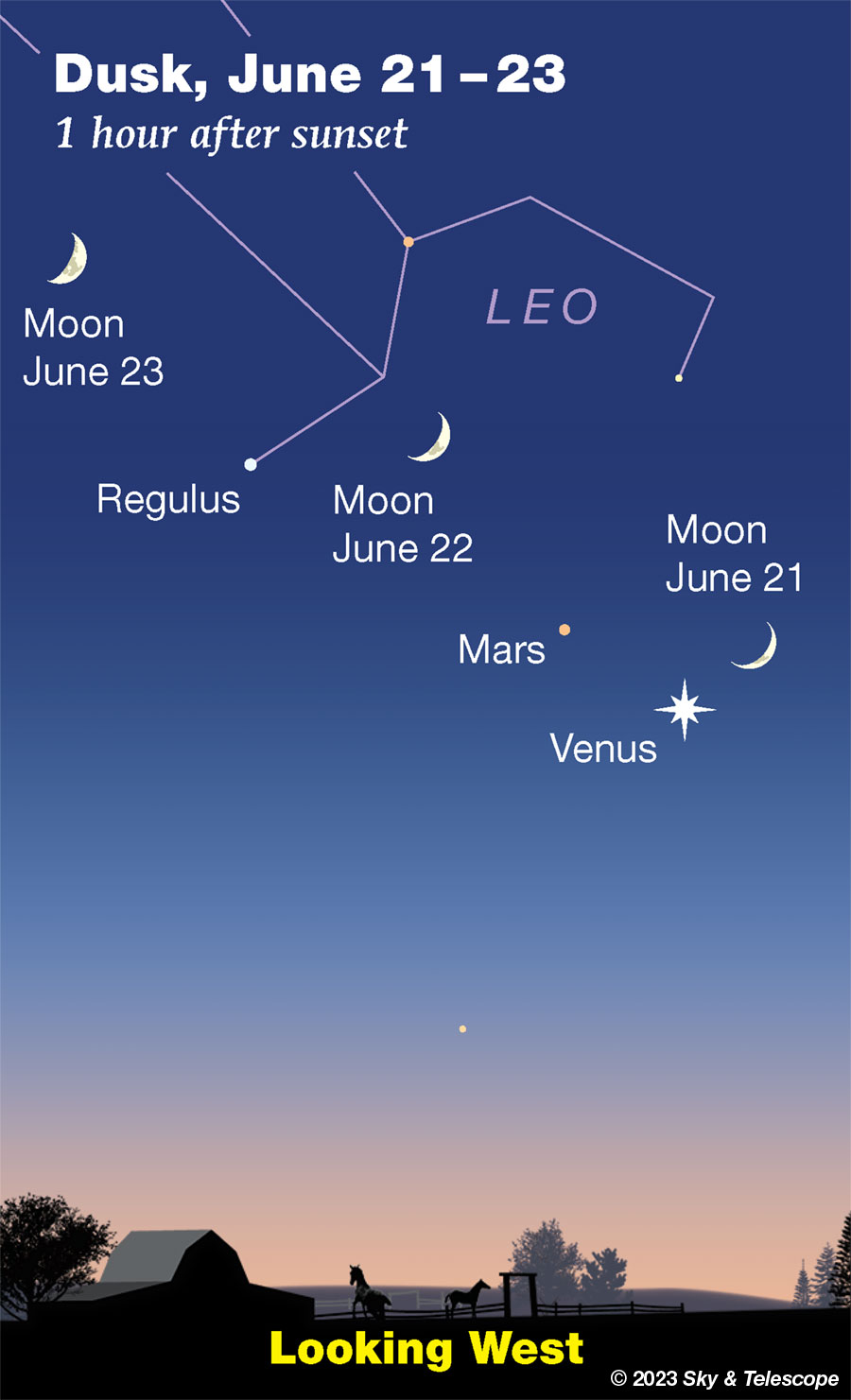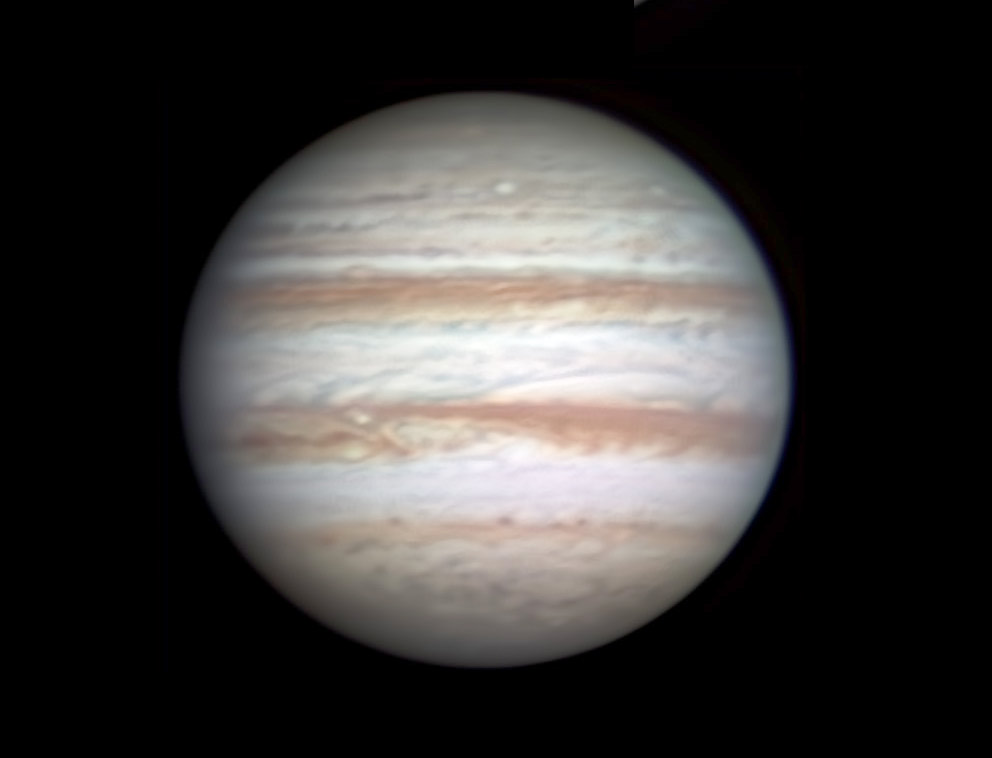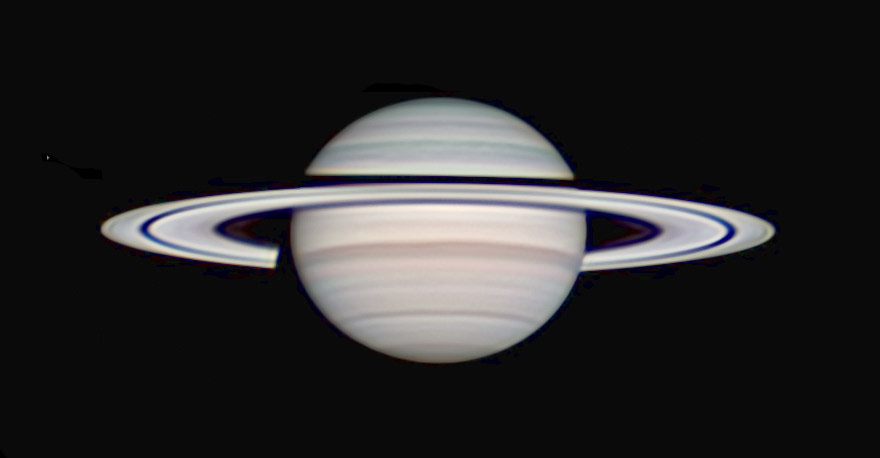Supernova in the Pinwheel Galaxy. Supernova 2023ixf, in M101 off the Big Dipper, is still in view of amateur telescopes. It's fading slowly; as of June 22nd it was magnitude 11.8, down from its May 25th peak of 11.1. It's also slightly reddening, or rather yellowing.
Supernovae usually do stay bright for weeks — sometimes with surprise variations, though this one has shown none so far. See Bright Supernova Blazes in M101, the Pinwheel Galaxy, with charts and comparison magnitudes.
FRIDAY, JUNE 16
■ The sky highlight of the week is the odd couple of Venus and Mars together in the west in late twilight, especially with the Moon about to join them on Wednesday the 21st.
Why odd? Because look what has happened to Mars. Back when the God of War was at opposition last December he was bold and blazing, even intimidating. But whenever he gets near the Goddess of Love — even brighter and bolder — he dwindles away to a weak, piddly little thing. Every time. What happens?
The ancients may have had their mythological explanations, but we know the truth. It's because 1) Venus is an inner planet, so we can never see it very far from the Sun in our sky, and 2) Mars is an outer planet, so when we see it anywhere near Venus — i.e. not very far from the Sun — it's on the far side of its orbit from us, nearly as distant as it can ever get.
■ As we count down the last five days to summer (the solstice is on June 21st), the Summer Triangle stands high and proud in the east after dark. Its top star is bright Vega. Deneb is the brightest star to Vega's lower left, by 2 or 3 fists at arm's length. Look for Altair a greater distance to Vega's lower right. Altair is midway in brightness between Vega and Deneb.
If you have a dark sky, the Milky Way runs across the lower part of the Summer Triangle from side to side.
As night progresses, look lower left of Altair for little Delphinus, the leaping Dolphin.
SATURDAY, JUNE 17
■ After dark look south-southeast for orange Antares, "the Betelgeuse of summer." Both are 1st-magnitude "red" supergiants. Around and upper right of Antares are the other, whiter stars of upper Scorpius, forming their distinctive pattern. The rest of the Scorpion curls down toward and along the horizon.
And spot Arcturus way up high toward the south. Three fists below it is Spica. A fist and a half to Spica's lower right, four-star Corvus, the Crow, is heading down and away.
SUNDAY, JUNE 18
■ Leo the Lion is mostly a constellation of late winter and spring. But he's not gone yet. As twilight ends look upper left of Venus and Mars for Regulus, Leo's brightest and now lowest star: the forefoot of the Lion stick figure.
The Sickle of Leo, his front part, extends upper right from Regulus. The Sickle aims at the two planets. The rest of the Lion's constellation figure extends for almost three fist-widths to the upper left, to his tail star Denebola, the highest.
He'll soon be treading off into the sunset.
■ New Moon (exact at 12:37 a.m. on this date EDT).
MONDAY, JUNE 19
■ This is the time of year when, after dark, the dim Little Dipper floats straight up from Polaris, the end of its handle, like a helium balloon on a string escaped from some warm backyard party. Through light pollution, however, all you may see of the Little Dipper are Polaris at its bottom and Kochab, the lip of the Little Dipper's bowl, at the top. The rest of its stars are fairly dim at 3rd to 5th magnitude.
TUESDAY, JUNE 20
■ The central stars of the little constellation Lyra, forming a small triangle and parallelogram, dangle lower right from bright Vega high in the east. The two brightest stars of the pattern, after Vega, are the two forming the bottom of the parallelogram: Beta and Gamma Lyrae. They're currently lined up vertically. Beta is the one on top.
Beta Lyrae is an eclipsing binary star. Compare it to Gamma whenever you look up at Lyra. Normally Beta is only a trace dimmer than Gamma. Eventually, however, you'll catch Beta when it is quite obviously dimmer than usual.
WEDNESDAY JUNE 21
■ Look west at dusk for the waxing crescent Moon beautifully paired with bright white Venus, as shown below. Catch Mars and Regulus as twilight deepens.

"You can try a fun experiment by starting your viewing session just before sunset," writes Gary Seronik in the June Sky & Telescope. "At that time you'll easily be able to spot the Moon, but how much later will Venus first appear?" You may find that you can pick out Venus even while the Sun is still up, and "certainly binoculars will make easy sport of it."
■ Welcome summer! The solstice arrives today at 10:58 a.m. EDT. This is when the Sun is farthest north for the year in Earth's sky and begins its six-month return southward. Summer officially begins in the Northern Hemisphere, winter in the Southern Hemisphere.
For us northerners, this is the year's longest day and shortest night.
It's also the day when (in the north temperate latitudes) the midday Sun passes the closest it ever can to being straight overhead, and thus when your shadow becomes the shortest it can ever be at your location. This happens at local apparent noon [solar noon], which is probably rather far removed from noon in your civil (clock) time.
And if you have a good west-northwest horizon, mark very precisely where the Sun sets when you stand at a given point. In a few days you should be able to detect that the Sun is again starting to set a just little south (left) of that point.
THURSDAY, JUNE 22
■ Now the Moon forms a line with Mars and Venus to its lower right, as shown above. And catch Regulus. At magnitude 1.3 it outshines Mars at mag 1.7.
The Moon forms a nearly isosceles triangle with Regulus and fainter Gamma Leonis above it. These are the two brightest stars of Leo's Sickle.
FRIDAY, JUNE 23
■ This is the time of year when the two brightest stars of summer, Arcturus and Vega, are about equally high overhead not too long after dark: Arcturus toward the southwest, Vega toward the east.
Arcturus and Vega are 37 and 25 light-years away, respectively. They represent the two commonest types of naked-eye star: Arcturus is a yellow-orange K giant, and Vega is a white A main-sequence star. They're 150 and 50 times brighter than the Sun, respectively — which, combined with their nearness, is why they dominate the sky.
SATURDAY, JUNE 24
■ The Moon, nearly first quarter, shines after dark about a fist-width under Denebola, Leo's tail-tip star.
SUNDAY, JUNE 25
■ First-quarter Moon tonight (exactly first-quarter at 3:50 a.m. Monday morning EDT). Now Denebola is about a fist and a half to the Moon's upper right. Brighter Spica is about two fists to the Moon's left.
This Week's Planet Roundup
Mercury is dropping lower down into the sunrise. Early in the week you might try for it with binoculars about 30 minutes before sunup. Scan just above the east-northeast horizon, very far lower left of Jupiter. At least Mercury is bright, about magnitude –1.0.
Venus (magnitude –4.6, in Cancer) is the brilliant "Evening Star" in the west through twilight into dark. It's getting lower every week. It now sets less than an hour after full darkness.
In a telescope Venus is a thick crescent, dazzling white, about 29 arcseconds from pole to pole. Venus will become a dramatically bigger, thinner crescent dropping lower until it's finally lost from sight in mid- to late July.
Mars (magnitude 1.7, crossing from Cancer into Leo) glows weakly a little to Venus's upper left, by a slightly shrinking distance: from 5.6° on June 16th to 4.1° by the 23rd.
But no conjunction is in store. Mars and Venus will reach a minimum separation of 3.6° on June 30th, then they'll start to draw apart again as Venus plunges down toward the sunset. This is called a quasi-conjunction, because they don't pass each other although they do get within 5° of each other.
In a telescope Mars is just a tiny little blob 4.3 arcseconds in diameter, since it's on the far side of its orbit from us.
Jupiter (magnitude –2.2, in Aries) is that bright "star" in the east before and during early dawn.

Saturn (magnitude +0.9, in dim Aquarius) rises around midnight or 1 a.m. By the beginning of dawn it's in good telescopic view high in the southeast.

Also notice the black on each side of the rings where they cross the planet's disk. The dark black south of (above) the rings is their shadow on the globe. The thinner, slightly grayer black to their north is the dim, sparse inner C ring, seen in front of the planet's bright face.
Uranus, magnitude 5.8 in Aries, is up low in the east-northeast by the beginning of dawn.
Neptune, magnitude 7.9 at the Aquarius-Pisces border, is high in the southeast before dawn begins. It's 20° east along the ecliptic from Saturn.
All descriptions that relate to your horizon — including the words up, down, right, and left — are written for the world's mid-northern latitudes. Descriptions and graphics that also depend on longitude (mainly Moon positions) are for North America.
Eastern Daylight Time (EDT) is Universal Time minus 4 hours. UT is sometimes called UTC, GMT, or Z time.
Want to become a better astronomer? Learn your way around the constellations. They're the key to locating everything fainter and deeper to hunt with binoculars or a telescope.
This is an outdoor nature hobby. For a more detailed constellation guide covering the whole evening sky, use the big monthly map in the center of each issue of Sky & Telescope, the essential magazine of astronomy.
Once you get a telescope, to put it to good use you'll need a much more detailed, large-scale sky atlas (set of charts). The basic standard is the Pocket Sky Atlas (in either the original or Jumbo Edition), which shows all stars to magnitude 7.6.

Next up is the larger and deeper Sky Atlas 2000.0, plotting stars to magnitude 8.5; nearly three times as many. The next up, once you know your way around, are the even larger Interstellarum atlas (stars to magnitude 9.5) or Uranometria 2000.0 (stars to mag 9.75). And be sure to read How to Use a Star Chart with a Telescope. It applies just as much to charts on your phone or tablet as to charts on paper.
You'll also want a good deep-sky guidebook. A beloved old classic is the three-volume Burnham's Celestial Handbook. An impressive more modern one is the big Night Sky Observer's Guide set (2+ volumes) by Kepple and Sanner.
Can a computerized telescope replace charts? Not for beginners, I don't think, and not on mounts and tripods that are less than top-quality mechanically. And as Terence Dickinson and Alan Dyer say in their Backyard Astronomer's Guide, "A full appreciation of the universe cannot come without developing the skills to find things in the sky and understanding how the sky works. This knowledge comes only by spending time under the stars with star maps in hand."
![]() Audio sky tour. Out under the evening sky with your
Audio sky tour. Out under the evening sky with your
earbuds in place, listen to Kelly Beatty's monthly
podcast tour of the heavens above. It's free.
"The dangers of not thinking clearly are much greater now than ever before. It's not that there's something new in our way of thinking, it's that credulous and confused thinking can be much more lethal in ways it was never before."
— Carl Sagan, 1996
"Facts are stubborn things."
— John Adams, 1770
 2
2









Comments
Anthony Barreiro
June 16, 2023 at 5:27 pm
The variable star R Coronae Borealis has dimmed dramatically in the past couple of weeks. Bob King's recent blog post "Eking out observing from under wildfire smoke" has details.
You must be logged in to post a comment.
Rod
June 19, 2023 at 5:03 am
I went out and looked at Jupiter and Saturn unaided eyes this morning. 0500 a good time slot at my location because of altitude and azimuth for these planets at this time. However, I still get smoke from Canada too. That is a real problem.
You must be logged in to post a comment.
You must be logged in to post a comment.